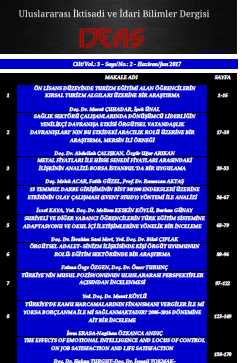SAĞLIK BİLİMLERİ FAKÜLTESİ ÖĞRENCİLERİNİN İLETİŞİM TARZLARININ AKADEMİK BAŞARILARINA ETKİSİ
Akademik başarı, İletişim Tarzı, Öğrenme Deneyimi
EFFECT OF COMMUNICATION STYLES OF FACULTY OF HEALTH SCIENCES STUDENTS ON THEIR ACADEMIC ACHIEVEMENTS
Academic Achievement Interpersonal Communication, Learning Experience, Style of Communication,
___
- Arifoğlu, B. and Gülcem, S. R. (2011). Relationship between empathy and communication skills of first year nursing students and academic achievement score of communication management course. Dokuz Eylul University School of Nursing Electronics Journal, 4(1):7-11.
- Bahadır, E. (2009). Psychological resilience levels of students starting education in health-related faculties. Unpublished Master Thesis, Ankara, Hacettepe University, Social Sciences Institute.
- Bernier, A. Jarry-Boileau, V. Lacharité, C. (2014). Marital satisfaction and quality of father–child ınteractions: The moderating role of child gender. The Journal of Genetic Psychology, 175(2):105-17.
- Boscart, M. V. (2009). A Communication Intervention for Nursing Staff in Chronic Care. Journal of Advanced Nursing, 65(9):1823-32.
- Brassart, E. and Schelstraete, M. A. (2015). Enhancing the communication abilities of preschoolers at risk for behavior problems: Effectiveness of a parent ımplemented language ıntervention. Infants and Young Children, 28(4):337-54.
- Brown, A. (2021). Stress Management Techniques, Strategies & Activities. https://positivepsychology.com/stress-management-techniques-tips-burn-out/ (Erişim tarihi, 15.10.2021).
- Cevahir, R. Çınar, N. Sözeri, C. Şahin, S. and Kuğuoğlu, S. (2008). Evaluation of empathy skills of midwifery students according to their classes. Fırat Journal of Health Services, 3(7):3-15.
- Collins, S. (2009). Good communication helps to build a therapeutic relationship. Nursing Times, 105(24):11.
- Çetin, C. Kurban, and P. Bilici, N. M. (2016). Healthy communication in healthcare institutions: Computer operators, security guards and referral workers sampling. Hacettepe Health Administration Journal, 19(4):423-42.
- Dalkılıç, M. (2006). Examining the problem solving and communication skills perceived in high school studnts' parent and adolescent relations according to some variables. Unpublished master thesis. İzmir: Ege University, Educational Sciences Institute.
- Erkuş, A. and Günlü, E. (2009). The effect of communication style and non-verbal communication on employees' job performance: a research in five-star hotel businesses. Anatolia. Journal of Tourism Research, 20(1):7-24.
- Koç Erdamar, G. (2015). Social learning theory. In: Ulusoy A, editor. Development and Learning Psychology. Ankara: Anı Publishing.
- Korap, N. (2013). The effect of perceived parental attitudes on adolescents' communication skills. Unpublished master's thesis. Istanbul: Marmara University Social Sciences Institute.
- Kumcağız, H. Yılmaz, M. Balcı Çelik, S. Aydın Avcı, I. (2011). Communication skills of nurses: Example of Samsun province. Dicle Medical Journal, 38(1):49-56.
- Lyubomirsky, S. King, L. and Diener, E. (2005). The benefits of frequent positive affect: Does happiness lead to Success? Psychological Bulletin, 131:803-55.
- Mete, S. and Gercek, E. (2005). Investigation of the empathic tendency and skills of nursing students who are trained with PBL Method. Cumhuriyet University Journal of Nursing School, 9(2):11-7.
- Nazlı, S. (2014). Family Counseling. 11th ed. Ankara: Anı Publication.
- Onay, M. Süslü, Z. and Kılcı, S. (2011). The effect of communication style and non-verbal communication on employees' job performance. A research on mail distributors and nurses. Journal of Social Economic Research, 11(21):139-76.
- Özer, K. (2006). Communication Ability Skill. 6th ed. Istanbul: Sistem Publishing.
- Özyazıcıoğlu, N. Aydınoğlu, N. and Aytekin, G. (2009). Examining the empathic and problem solving skills of the students of the School of Health. Journal of Atatürk University School of Nursing, 12(3):46-53.
- Pekkan, N. Ü. & Çalışkan, A. (2020). YARATICI TAKIM İKLİMİ ÖLÇEĞİ: TÜRKÇE’YE UYARLAMA, GEÇERLİLİK VE GÜVENİRLİK ÇALIŞMASI . İstanbul Ticaret Üniversitesi Sosyal Bilimler Dergisi , 19 (39) , 1007-1021 . DOI: 10.46928/iticusbe.768433
- Reynolds, W. and Scott, B. (2000). Do nurses and other professional helpers normally display much empathy? Journal of Advanced Nursing, 31(1):226-34.
- Soylu, Y. and Kağnıcı, D. Y. (2015). Prediction of marital adjustment according to empathic tendency, communication and conflict resolution styles. Turkish Psychological Counseling and Guidance Journal, 5(43):44-54.
- Şahin, N. Durak, A. and Yasak, Y. (1994). Interpersonal style, lone liness and depression. 23rd International Congress of Applied Psyclology, July l7-22, Madrid, SPAIN.
- Temel, D. and Türkoğlu, B. (2019). The effect of parental attitudes on the social skills of pre-school children according to their settlements. Gazi University Faculty of Education Journal, 39(2):843-71.
- Tutuk, A. Al, and D. Dogan, S. (2002). Determining communication skills and empathy levels of nursing students. C.U. Nursing High School Journal, 6(2):36-41.
- Wilkinson, S. Linsell, L. and Blanchard K. (2008). Communication skills training for nurses working with patients with heart disease. British Journal of Cardiac Nursing, 3(10):475-81.
- Yalçın, S. (2019). Thinking Positive for Happiness. Ankara: Songür Education Services.
- Yarış, F. and Dikici, M. F. (2008). Patient compliance and communication. Journal of Family Practice, 2:40-3.
- Yeşilyaprak, B. (2005). Development and Learning Psychology. 9th ed. Ankara: Pegem Publishing.
- ISSN: 2149-5823
- Başlangıç: 2015
- Yayıncı: Ömer TURUNÇ
ANAYASA’NIN 73. MADDESİ IŞIĞINDA BENZERİ MALİ YÜKÜMLÜLÜK : KÜLTÜREL KATKI PAYI
TÜRKİYE’DE ULUSLARARASI İLİŞKİLER DİSİPLİNİNİN GELİŞİMİ
Aydan KAYSERİLİ, Elif Burcu ATÇI
ÖRGÜTSEL ETİK İKLİMİ: BİR ÖLÇEK GELİŞTİRME ÇALIŞMASI
Oya KORKMAZ, Ayhan DEMİRCİ, Selin BOLAT, Pınar BEDLEK, Hüseyin Alparslan İŞBİLİR
SAĞLIK BİLİMLERİ FAKÜLTESİ ÖĞRENCİLERİNİN İLETİŞİM TARZLARININ AKADEMİK BAŞARILARINA ETKİSİ
